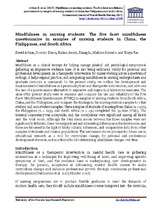| dc.contributor.author | Arthur, David | |
| dc.contributor.author | Dizon, Doroteo | |
| dc.contributor.author | Jooste, Karien | |
| dc.contributor.author | Li, Zheng | |
| dc.contributor.author | Salvador, Mathew | |
| dc.contributor.author | Yao, Xiuyu | |
| dc.date.accessioned | 2018-02-15T08:41:28Z | |
| dc.date.available | 2018-02-15T08:41:28Z | |
| dc.date.issued | 2017 | |
| dc.identifier.citation | Arthur, D. et al. (2017). Mindfulness in nursing students: The five facet mindfulness questionnaire in samples of nursing students in China, the Philippines, and South Africa. International Journal of Mental health Nursing, | en_US |
| dc.identifier.issn | 1445-8330 | |
| dc.identifier.uri | http://dx.doi.org/10.1111/inm.12405 | |
| dc.identifier.uri | http://hdl.handle.net/10566/3493 | |
| dc.description.abstract | Mindfulness as a clinical strategy for helping manage physical and psychological
symptoms is gathering an impressive evidence base. It is also being embraced widely for personal
and professional development. As a therapeutic intervention for nurses working across a spectrum
of settings, it helps expand practice, and integrating mindfulness in nursing undergraduate and
graduate curricula is imminent. In the present study, we outline the development and
measurement of mindfulness as a personality trait and therapeutic intervention, and advocate the
use of a questionnaire alternative to expensive and impractical laboratory measures. The aims of
the present study were to examine and compare the use and reliability of the Five Facet
Mindfulness Questionnaire (FFMQ) in samples of nursing students from South Africa, China, and
the Philippines, and compare the findings in the nursing student samples to other student and
non-student samples. Three samples of students of nursing from China (n = 193), the Philippines
(n = 243), and South Africa (n = 131) completed the 31-item FFMQ. The internal consistency
was acceptable, and the correlations were significant among all facets and the total score.
Although the total mean scores between the three samples were not significantly different, there
were significant and interesting differences in the facet scores, and these are discussed in the light
of likely cultural influences, and comparative data from other samples of students and clinical
populations. The instrument shows promise for future use in educational research as a tool for
curriculum change, for personal and professional development of nurses, and as a clinical tool for
determining mindfulness changes over time. | en_US |
| dc.language.iso | en | en_US |
| dc.publisher | Wiley | en_US |
| dc.rights | This is the author-version of the article published online at: http://dx.doi.org/10.1111/inm.12405 | |
| dc.subject | Cultural difference | en_US |
| dc.subject | Mindfulness | en_US |
| dc.subject | Nursing | en_US |
| dc.subject | Personal development | en_US |
| dc.title | Mindfulness in nursing students: The five facet mindfulness questionnaire in samples of nursing students in China, the Philippines, and South Africa | en_US |
| dc.type | Article | en_US |
| dc.privacy.showsubmitter | FALSE | |
| dc.status.ispeerreviewed | TRUE | |
| dc.description.accreditation | Scopus | |
| dc.description.accreditation | ISI | |

